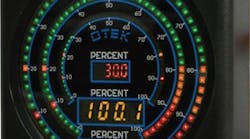You can make a case that there's not much difference in the science behind a loop-powered display today compared with the device invented by Sir Edward Weston in 1893. Just like Weston's devices, a contemporary version uses minute amounts of energy in a current loop for power. While the science is the same, it's the product enhancements over the years that will cause one brand to differentiate itself from others.
Otek says its been doing that all along, and its latest example is the new LPD Series loop-powered display, built—as the latest successor to the original analog voltmeter—to brightly and consistently illuminate its 51 automatic tricolor (R/G/Y) bargraph and four digits.
"But that's not all," says Dr. Otto Fest, founder and president of Otek, which has been designing and building these devices since 1974. "The LPD is 100% DCS/SCADA/Ethernet-compatible with its serial I/O capabilities, all of it loop-powered. In addition, it tells the operator if and when the loop fails by flashing its display message 'Loop Fail,' and transmits the distress message via serial with ID, date and time stamp for about 20 seconds before going dark."
How does it work? The LPD uses less than 12 mW@4 mA (<60 mW@20 mA) to run its ASIC processor and high-efficiency bicolor display and isolated serial interface, Fest says, adding that it requires only about 3 V burden on the loop, compared to about 1 V of the analog counterpart. "The alarm ‘after the fact,' or the dead loop, is handled by a unique energy storage technique used by the PLD to store power when the loop is operating normally, which is after about 30 seconds. And, if and when the loop fails shorted or open, that energy is used to flash its display, and transmit the distress message to supervisory equipment for about 20 seconds before going dark."
Otek is also expanding the LPD series with the addition of the loop-powered controller (LPC) series of bargraphs, and will include isolated retransmission (4-20 mA out), isolated alarms (four), relays and PoE. "While the LPC will require external power for the outputs, it will maintain the loop-powered features of the LPD," Fest explains.
Fest also stresses that no rewiring is required. "This is considered a very important feature by control room managers," he explains. "Since the new technology is a 100% drop-in replacement for analog meters (only two wires), there is no need to reengineer power or signal lines, as is required by conventional digital meters. And, if you want to integrate the LPD with DCS/SCADA, the serial I/O is already there. Just connect the LPD in parallel with the analog meter and disconnect the old."
Otek owns several patents on powerless technology. "The next variation to be released will be the SPD/SPC Series of signal-powered display/controllers," Fest says. "This series will use less than 50 mW of an ac signal to power the display, rather than use the loop power."
For more information call 520-748-7900, email [email protected] or browse to www.otekcorp.com.



